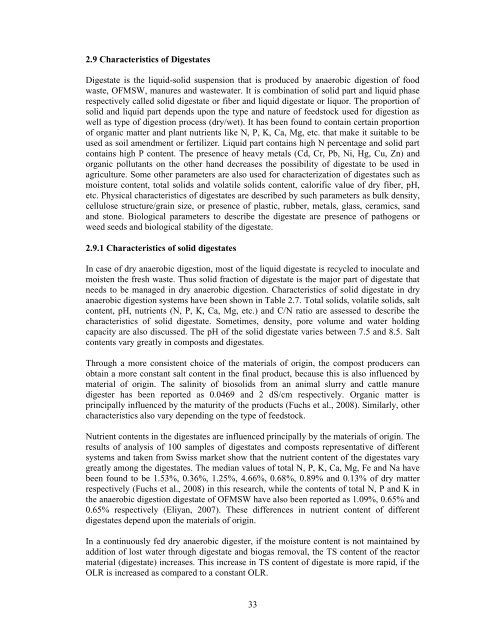dry anaerobic digestion of municipal solid waste and digestate ...
dry anaerobic digestion of municipal solid waste and digestate ...
dry anaerobic digestion of municipal solid waste and digestate ...
Create successful ePaper yourself
Turn your PDF publications into a flip-book with our unique Google optimized e-Paper software.
2.9 Characteristics <strong>of</strong> Digestates<br />
Digestate is the liquid-<strong>solid</strong> suspension that is produced by <strong>anaerobic</strong> <strong>digestion</strong> <strong>of</strong> food<br />
<strong>waste</strong>, OFMSW, manures <strong>and</strong> <strong>waste</strong>water. It is combination <strong>of</strong> <strong>solid</strong> part <strong>and</strong> liquid phase<br />
respectively called <strong>solid</strong> <strong>digestate</strong> or fiber <strong>and</strong> liquid <strong>digestate</strong> or liquor. The proportion <strong>of</strong><br />
<strong>solid</strong> <strong>and</strong> liquid part depends upon the type <strong>and</strong> nature <strong>of</strong> feedstock used for <strong>digestion</strong> as<br />
well as type <strong>of</strong> <strong>digestion</strong> process (<strong>dry</strong>/wet). It has been found to contain certain proportion<br />
<strong>of</strong> organic matter <strong>and</strong> plant nutrients like N, P, K, Ca, Mg, etc. that make it suitable to be<br />
used as soil amendment or fertilizer. Liquid part contains high N percentage <strong>and</strong> <strong>solid</strong> part<br />
contains high P content. The presence <strong>of</strong> heavy metals ( Cd, Cr, Pb, Ni, Hg, Cu, Zn) <strong>and</strong><br />
organic pollutants on the other h<strong>and</strong> decreases the possibility <strong>of</strong> <strong>digestate</strong> to be used in<br />
agriculture. Some other parameters are also used for characterization <strong>of</strong> <strong>digestate</strong>s such as<br />
moisture content, total <strong>solid</strong>s <strong>and</strong> volatile <strong>solid</strong>s content, calorific value <strong>of</strong> <strong>dry</strong> fiber, pH,<br />
etc. Physical characteristics <strong>of</strong> <strong>digestate</strong>s are described by such parameters as bulk density,<br />
cellulose structure/grain size, or presence <strong>of</strong> plastic, rubber, metals, glass, ceramics, s<strong>and</strong><br />
<strong>and</strong> stone. Biological parameters to describe the <strong>digestate</strong> are presence <strong>of</strong> pathogens or<br />
weed seeds <strong>and</strong> biological stability <strong>of</strong> the <strong>digestate</strong>.<br />
2.9.1 Characteristics <strong>of</strong> <strong>solid</strong> <strong>digestate</strong>s<br />
In case <strong>of</strong> <strong>dry</strong> <strong>anaerobic</strong> <strong>digestion</strong>, most <strong>of</strong> the liquid <strong>digestate</strong> is recycled to inoculate <strong>and</strong><br />
moisten the fresh <strong>waste</strong>. Thus <strong>solid</strong> fraction <strong>of</strong> <strong>digestate</strong> is the major part <strong>of</strong> <strong>digestate</strong> that<br />
needs to be managed in <strong>dry</strong> <strong>anaerobic</strong> <strong>digestion</strong>. Characteristics <strong>of</strong> <strong>solid</strong> <strong>digestate</strong> in <strong>dry</strong><br />
<strong>anaerobic</strong> <strong>digestion</strong> systems have been shown in Table 2.7. Total <strong>solid</strong>s, volatile <strong>solid</strong>s, salt<br />
content, pH, nutrients (N, P, K, Ca, Mg, etc.) <strong>and</strong> C/N ratio are assessed to describe the<br />
characteristics <strong>of</strong> <strong>solid</strong> <strong>digestate</strong>. Sometimes, density, pore volume <strong>and</strong> water holding<br />
capacity are also discussed. The pH <strong>of</strong> the <strong>solid</strong> <strong>digestate</strong> varies between 7.5 <strong>and</strong> 8.5. Salt<br />
contents vary greatly in composts <strong>and</strong> <strong>digestate</strong>s.<br />
Through a more consistent choice <strong>of</strong> the materials <strong>of</strong> origin, the compost producers can<br />
obtain a more constant salt content in the final product, because this is also influenced by<br />
material <strong>of</strong> origin. The salinity <strong>of</strong> bio<strong>solid</strong>s from an animal slurry <strong>and</strong> cattle manure<br />
digester has been reported as 0.0469 <strong>and</strong> 2 dS/cm respectively. Organic matter is<br />
principally influenced by the maturity <strong>of</strong> the products (Fuchs et al., 2008). Similarly, other<br />
characteristics also vary depending on the type <strong>of</strong> feedstock.<br />
Nutrient contents in the <strong>digestate</strong>s are influenced principally by the materials <strong>of</strong> origin. The<br />
results <strong>of</strong> analysis <strong>of</strong> 100 samples <strong>of</strong> <strong>digestate</strong>s <strong>and</strong> composts representative <strong>of</strong> different<br />
systems <strong>and</strong> taken from Swiss market show that the nutrient content <strong>of</strong> the <strong>digestate</strong>s vary<br />
greatly among the <strong>digestate</strong>s. The median values <strong>of</strong> total N, P, K, Ca, Mg, Fe <strong>and</strong> Na have<br />
been found to be 1.53%, 0.36%, 1.25%, 4.66%, 0.68%, 0.89% <strong>and</strong> 0.13% <strong>of</strong> <strong>dry</strong> matter<br />
respectively (Fuchs et al., 2008) in this research, while the contents <strong>of</strong> total N, P <strong>and</strong> K in<br />
the <strong>anaerobic</strong> <strong>digestion</strong> <strong>digestate</strong> <strong>of</strong> OFMSW have also been reported as 1.09%, 0.65% <strong>and</strong><br />
0.65% respectively (Eliyan, 2007). These differences in nutrient content <strong>of</strong> different<br />
<strong>digestate</strong>s depend upon the materials <strong>of</strong> origin.<br />
In a continuously fed <strong>dry</strong> <strong>anaerobic</strong> digester, if the moisture content is not maintained by<br />
addition <strong>of</strong> lost water through <strong>digestate</strong> <strong>and</strong> biogas removal, the TS content <strong>of</strong> the reactor<br />
material (<strong>digestate</strong>) increases. This increase in TS content <strong>of</strong> <strong>digestate</strong> is more rapid, if the<br />
OLR is increased as compared to a constant OLR.<br />
33

















